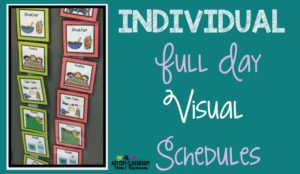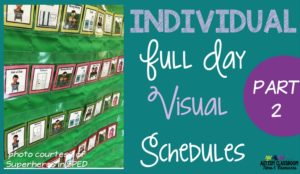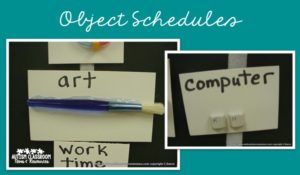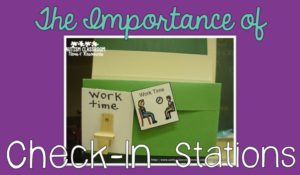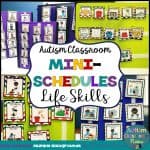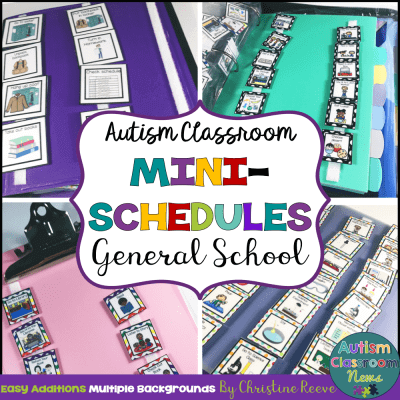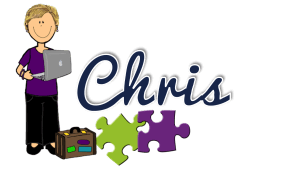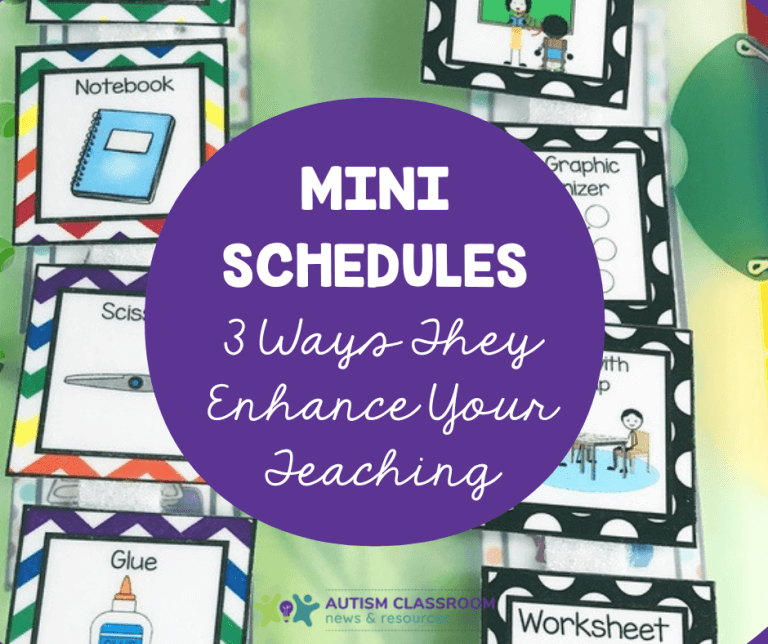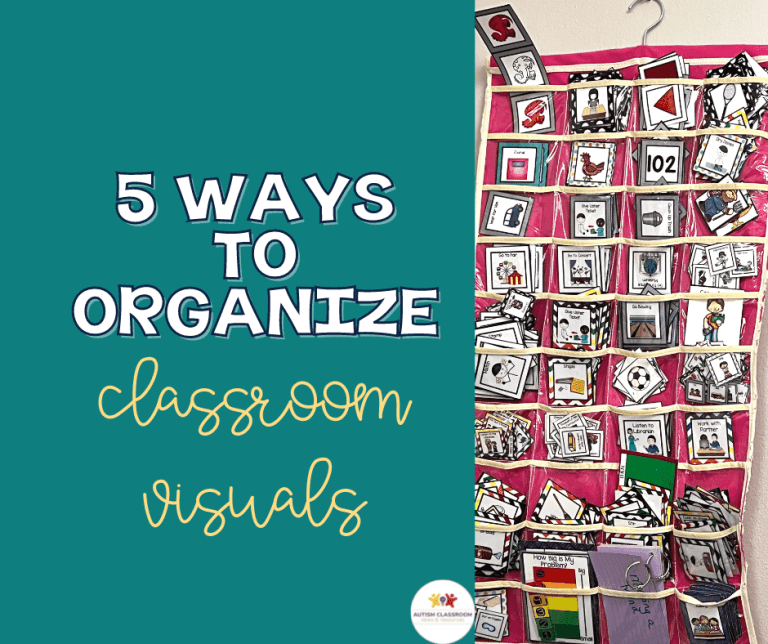Classroom visuals for Autism are the next step in the 10 Steps to a Well-Run Classroom. Since we’ve talked about learning about the students, creating the schedule, organizing the room, and zoning the staff, we have a solid foundation on which we can start to
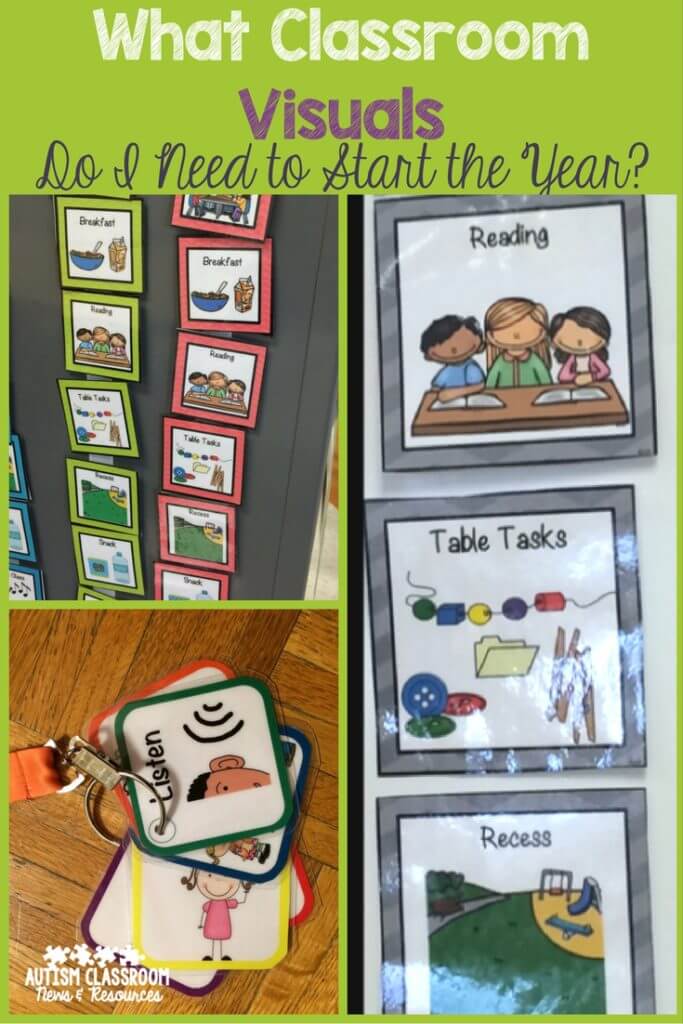 integrate our strategies. One of the most fundamental strategies for an Autism classroom, as well as any other special education students needs, is the use of visuals. Visuals are a great way to set expectations, to help students understand our communication and to communicate on their own. But where do you start with visuals? Today’s post will give you a wide range of useful visual supports for the classroom, along with some links back to previous ones about different types of visuals I use in the classroom.
integrate our strategies. One of the most fundamental strategies for an Autism classroom, as well as any other special education students needs, is the use of visuals. Visuals are a great way to set expectations, to help students understand our communication and to communicate on their own. But where do you start with visuals? Today’s post will give you a wide range of useful visual supports for the classroom, along with some links back to previous ones about different types of visuals I use in the classroom.
For a run-down of what visuals I think are essential to start the year, join our Facebook Live sessions tonight (Sunday, 8/14/15) at 7:30 PM eastern or watch the replay at the end of this post.
Individual Schedules
Probably one of the most important kind of classroom visual strategies, and the one most people are familiar with, is the individual schedule. Sometimes these are picture schedules, sometimes written schedules. They can be used in many different ways and they give each student their own visual for the day. They inform the student of their daily schedule and which activities they will be doing each day. They are the first type of visual I put up in the classroom. To read more about different ways individual schedules can look and be used, check out the posts below:
Check-In Stations
Sometimes we call them parking lots. Sometimes we call them check-in stations or just check-ins. Essentially they serve two functions. First they are a sign that shows what activity is taking place in which area of the room. This helps all the students, even those who don’t carry their visuals with them. Second, they are a place for students who do carry their visuals to place their visual. Hence they are a great tool to check-in to the area. I firmly believe that this is a critical component for a classroom, particularly if students are learning how to use the schedule. You can read more about how to set them up and why they are important in the post below. It’s important to remember to use the same visuals the students use on the check-in. So if you have students using object schedules and picture schedules, both would be included on the check-in station.
Visual Schedule Series: The Importance of Check-In Stations
Group Schedules
Group schedules show the students the daily routine of what the whole class is doing. They are important for many reasons, but one is that it is the type of schedule we are typically trying to move students towards. General education classrooms often have group schedules. So if the students can follow along with them, they may not need extra visual support. This makes coordinating between the teachers that much easier. And it makes the student more independent. Like all schedules you can have many kinds. People tend to leave them out when they create a classroom. Many people think the students’ individual schedules are sufficient. However, if we want the classroom to run like a group, I think referring back to and reviewing the group schedule regularly through the day is important.
For examples and ideas about why the group schedule is important, check out: Visual Schedule Series: 5 Reasons to Use Group Schedules
Mini-Schedules
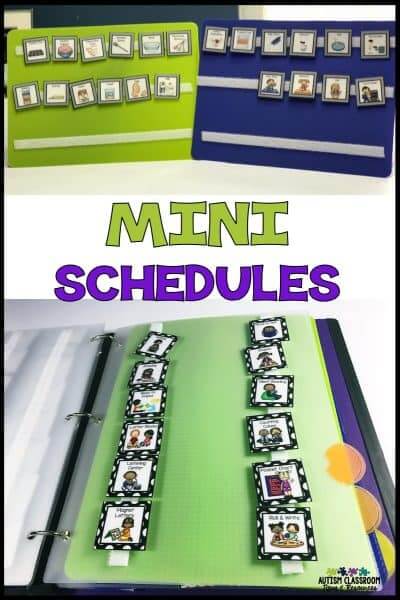 Mini-schedules or activity schedules are classroom visuals for Autism that depict the steps of an activity or routine. We commonly use schedule cards for routines in the classroom, like arrival and using the bathroom. We might also use them for activities like jobs, community outings and other activities.
Mini-schedules or activity schedules are classroom visuals for Autism that depict the steps of an activity or routine. We commonly use schedule cards for routines in the classroom, like arrival and using the bathroom. We might also use them for activities like jobs, community outings and other activities.
I would say for the beginning of the year, start out with mini-schedules to some common routines. Perhaps choose 3, if you haven’t done this before. I would do bathroom, arrival and departure as the first ones to set up. Then as you see areas where students need more visual support, you can always add them in.
To see more examples and grab a freebie for a leisure schedule, check out the posts below.
- Visual Schedule Series: Mini-Schedules for Routine Tasks
- Visual Schedule Series: More Mini-Schedules for Routine Tasks
- Visual Schedule Series: Mini Schedules for Activities (and a Freebie!)
- Visual Schedule Series: Mini-Schedules for Work and Community-Based Intervention
Click the pictures to see them in my store.
Classroom Visuals for Autism and Behavioral Support
The next layer of visuals for the classroom are the ones that set expectations, prevent challenging behaviors and help with your behavior management. Some of these are the ones I always forget. These classroom visuals for Autism address 3 main issues to prevent challenging behavior and promoting positive behaviors.
- They tell students the expected behaviors for their learning environment, such as posted rules. They also support our communication to the students (e.g., visual lanyard). There is a freebie of classroom rules in the post below. They also can tell students when something is off limits.
- They tell students where to be in space. Feet on the floor and visuals on the floor and table let them know where to sit and stand. They are deliberately set up at distances so that the students are far enough apart from each other that they can’t touch each other.
- These visuals might also include breaking tasks down into smaller components using something like a first-then board.
For beginning the year, I would start with feet on the floor and visuals on the table of where to sit. You can fine tune where the students sit as you get to know them. If you now that you have a student who has an obsession with something like the computer, consider starting with a finished sign or covering over that to prevent problems. Classroom visuals for Autism and for individual behavior programs are also essential to start the year.
- 5 Types and Functions of Visual Supports; Antecedent Interventions for Behavioral Support
- Visuals Can Set Limits: Freebie!
Classroom Visuals for Staff
Next up it’s important to remember that staff benefit from visual reminders as well. Visuals that remind them the steps to teach, the prompting hierarchy, and to reduce verbal prompts are all ones I might start out with. As you get to know your staff, you can determine what additional supports are needed. You can read more about different types of visual supports and download a freebie in the posts below.
- Visual Cues for Adults in Structured Work Systems (Freebie!)
- Discrete Trial Procedures Visual Reminders (Free!): Even Adults Need Visual Cues
- 3 Ways to Get Adult Language in the Classroom Back on Track with a Freebie
Classroom Visuals That Travel the School
It’s critical that we don’t think that the need for classroom visuals for Autism stop at the special education teachers classroom door. When students leave our rooms, they need visuals even more. The school outside the special education classroom is more complex and more confusing. Consequently visuals are needed MORE.
So, we have to come up with ways to carry them and have them travel easily. One way is to have the specials (PE, Art, Music) teachers have their own set of visuals to use to set up activities. You can read more about those in the posts below.
- Schedule Visuals for PE
- Visual Supports for Art Teachers
- Visuals to Support Music Class
- Visual Schedule Series: Using Schedules Everywhere
Check out my visual schedule bundles for all ages on TPT if you are interested the collection of visual supports that you have seen in some of the pictures. The books linked below are also useful to get started with classroom visuals for Autism and visual schedules.
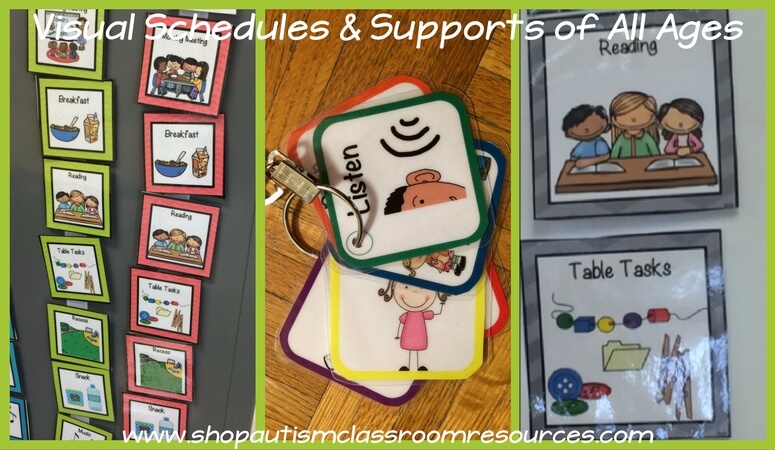
Until next time,


